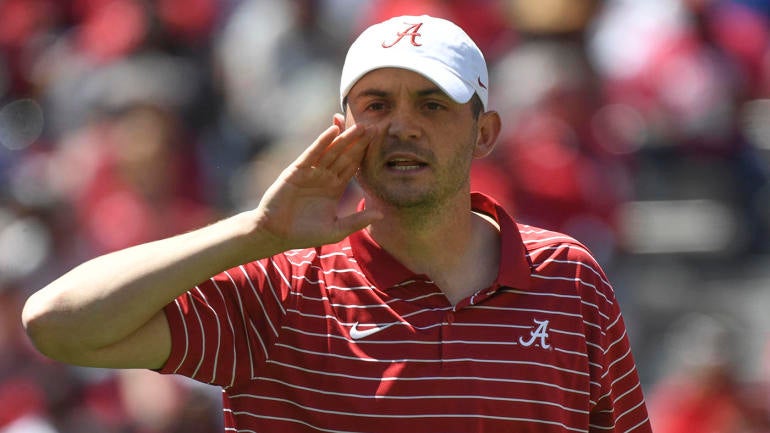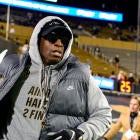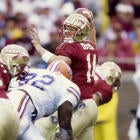
The Alabama quarterback battle is among the most-discussed storylines in college football as the 2023 season approaches. The uncertainty at the most important position on the field may have played a factor in why the No. 4 Crimson Tide have their lowest preseason ranking in the AP Top 25 since 2009, but the reality is that Alabama has more questions to answer on offense than who will be under center on Sept. 2 against Middle Tennessee.
It's been a while since Tuscaloosa has seen this kind of competition. The program has enjoyed an elite line of succession from Jalen Hurts to Tua Tagovailoa to Mac Jones to Bryce Young. That's one of the reasons this battle has demanded so much attention, particularly ahead of a season where Alabama is looking to reclaim its spot at the top of the SEC after last season seeing LSU win the West and Georgia win the league en route to a second consecutive national championship.
If Alabama is going make a College Football Playoff return, the quarterback play needs to be serviceable. But an offseason of change on offense is not limited to quarterback, and lingering issues that contributed to last season's playoff-less finish must be addressed for any of these QB1 contenders to be set up for the highest levels of success this fall.
So before we get to our expectations for the battle between Jalen Milroe, Ty Simpson, Tyler Buchner and Dylan Lonergan, it's important to highlight the other questions around the Tide offense.
Is there consistency at wide receiver?
Heightened performance at quarterback has helped Alabama's offense evolve the past few years. Going hand-in-hand with that upgrade, however, has been the ability to overwhelm opposing secondaries with multiple future NFL Draft picks at wide receiver. Jerry Jeudy, De'Vonta Smith, Jaylen Waddle and Henry Ruggs had as much of a hand in the Crimson Tide fielding one of the most explosive offenses of the College Football Playoff era, and while Bryce Young enjoyed one year of Jameson Williams and John Metchie en route to a Heisman Trophy in 2021, there was a noticeable drop off at the position in 2022.
Leading receivers Jermaine Burton (40 receptions, 677 yards, seven touchdowns) and Ja'Corey Brooks (39 receptions, 674 yards, eight touchdowns) are back along with sophomores Isaiah Bond and Kobe Prentice. Still, the group as a whole received some criticism through spring practice and early fall camp for lack of consistency. A wide receiver drop on a well-executed play is just as unnerving to a mistake-averse coach like Nick Saban as a bad throw or interception. He let the media know when the group was under-performing, though the good news is that things seem to be improving.
"Our receivers have really improved," Saban said after Alabama's second scrimmage on Saturday. "They have played faster. They are playing with more confidence. We have had fewer drops. They've made improvements. We made improvements in the passing game. We're more consistent in what we are doing, and we are more confident. That's helpful to the quarterbacks as well as the confidence of the receivers."
A real X-factor for this group will be the play of Malik Benson, the top-rated junior college prospect from the 2023 class. Saban has noted Benson's strong performance means he could be a real contributor to the offense. Benson could provide a cushion if some of the returning receivers prove inconsistent at times this fall.
Can the OL clean up mistakes, dominate with physicality?
Improved wide receiver play can be extremely helpful for a quarterback's performance, but so can having an offensive line that will not only provide adequate protection but dominate the line of scrimmage to power an effective run game.
When you recruit like Alabama, the lines of scrimmage are going to be an on-paper advantage against most teams on the schedule. There just aren't a lot of human beings who stand 6-foot-5 or so, weigh 330-ish pounds and display elite athleticism, but you'll find a lot of them in Alabama's offensive line room. But being able to truly dominate requires a consistent level of physicality and execution, and it's that latter part that makes finding the right players for the right spots so important.
With all the checks, calls and communication required at the line of scrimmage in a modern offense, it creates another level where simply being bigger than the opponent is not enough. Alabama has had an on-paper size advantage before, but last year the offensive line couldn't get out of its own way. Pre-snap penalties at the line of scrimmage contributed to Alabama having the second-most penalties per game in the SEC (7.9), and some of those errors were back-breakers in key moments of an offensive drive.
Among the fall camp takeaways has been a shuffling along the offensive line to provide some experience to the left side where freshman Kadyn Proctor, a five-star prospect in the 2023 class, is battling redshirt freshman Elijah Prtichett for the tackle spot opposite JC Latham.
"[The left side of the offensive line] has made a lot of improvement," Saban said. "We moved some guys around to balance the experience a little bit more. Tyler Booker played left guard last year. He was playing right guard and is moving back to left guard. That's helped the left tackles who are less experienced. He is somebody that's got more experience, more confidence, can make calls and can help them with their communication. That doesn't mean that's the way it's going to be, but that's one thing that has helped that side of the line to some degree."
If the offensive line is in sync and limiting mistakes, then it should be able to overwhelm opposing defensive fronts and open up holes for a deep running back room that includes Jase McClellan, Roydell Williams and Jam Miller. With plenty of capable options -- including highly touted freshman Justice Haynes, who is missing time with a quad injury -- expect that group to split carries and keep bodies fresh deep into games and into the season. If Alabama can avoid penalties and run the ball at an elite level, it won't need to lean on its passing game to get out of tough down-and-distance situations.
Is Tommy Rees an upgrade at offensive coordinator?
Whether Bill O'Brien was a good fit for Alabama is a fair debate. His first season as offensive coordinator included a Heisman Trophy for Bryce Young, an SEC championship and runner-up showing in the College Football Playoff. If the Crimson Tide don't suffer multiple injuries at wide receiver, maybe there's another outcome that doesn't sting as much as falling to Georgia on the game's biggest stage. But there were also stretches in 2022 when the offense displayed very little rhythm or cohesion. Last season's 32-31 overtime loss to LSU stands out the most in this conversation; it took nine offensive possessions before Alabama found the end zone that night in Baton Rouge.
There is blame to be had along the offensive line and wide receivers, as mentioned above, but play-calling and game-planning has to shoulder some of that responsibility as well. So what can new offensive coordinator Tommy Rees do to avoid those kind of sputtering stretches that can cost Alabama a game, and in turn a shot at the SEC or national championship?
On the surface, Rees, 31, does bring a youthful spark to the process that could not be matched by his predecessor. Reports dating all the way back to spring practice indicated he'd gotten solid buy-in from the group with players referencing not only his energy but also his approach to the offense. The expectation with Rees is not set to one certain scheme or style, but instead how he builds up an offensive attack with one play setting up the next. Every coordinator in the country believes they are playing chess with the defense, but the pieces are different at Alabama. Rees can make a bishop look like a knight or a rook like a king, and on the Crimson Tide roster, there's not a pawn to be found.
So can Rees, with the most talented offense he's ever coached, be an upgrade from O'Brien? And can he do it without Young? Those questions focused on the sideline are just as significant as deciding who will be the starting quarterback for Alabama.
Speaking of, let's circle back ...
How long will it take to name a starting QB?
The privileged position of having quarterback not only set but occupied by an elite talent has been quite a change from the run that saw Saban put multiple "or" designations on the depth chart with names like Cooper Bateman and Blake Barnett battling for QB1. In those years, there would be multiple quarterbacks set up to see action in the season opener and the assumption was that the starter would emerge in time for Week 2 or Week 3.
This season, there is only 60 minutes of live action for Saban and Rees to find the quarterback that gives Alabama the best chance to compete at the highest level as Week 2 brings a Texas team to town that stymied the Crimson Tide offense last season. If a Bryce Young-led group could only muster 20 points against the Longhorns, there has to be a level of confidence in both the quarterback and the offense as a whole going into a game that could play a key role in Alabama's pursuit of a College Football Playoff return. Those four quarters against Middle Tennessee on Sept. 2 are key to establishing a connection and confidence with all the other pieces mentioned above. Even a sloppy performance against the Blue Raiders could probably produce a win, with plenty of yards and points along the way, but the habits of competition must be established at a high level or the group will get exposed the following week.
Habits are key when it comes to Saban and his signal-callers. Every bad throw, sack or interception could be indicative of a bad habit that is preventing one of these players from winning the job to this point. Milroe has experience on his side and has flashed some high-end potential in fall camp, but there are some throws that are providing evidence on the other side of the scale. Simpson has the least game experience of the three competitors, but the inability to win the job suggests his five-star projections coming out of high school have not yet been realized. While Notre Dame transfer Tyler Buchner has played all kinds of roles in his brief college career, including both as a rotational player and the unquestioned starter, the body of work includes some of the mistakes that could prevent him from ascending to the top line of the depth chart.
Ultimately, we should assume that the starting QB for Week 1 will be the player who gives the offense the highest floor rather than the highest ceiling -- the one who can limit mistakes and set up the rest of the team for success within the framework of Rees' new offense. That's why whomever wins the job is important, to a point, but whether Alabama is competing for the national championship is a question that has to be answered by the entire group.






















